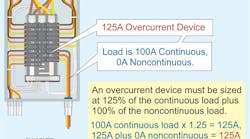Stumped by the Code? Sizing Overcurrent Protection for Branch Circuits, Class III Hazardous (Classified) Location, Minimum Clearances of Overhead Feeder Conductors, and More
All questions and answers are based on the 2011 NEC.
Q. What is the Code rule for sizing overcurrent protection for branch circuits [210.20]?
A. Branch circuit overcurrent devices must have a rating of not less than 125% of the continuous loads, plus 100% of the noncontinuous loads [210.20(A)], as shown in the Figure. Branch-circuit conductors must be protected against overcurrent in accordance with 240.4 [220.20(B)].
Q. When are receptacles required to be tamper-resistant?
A. All nonlocking type 15A and 20A, 125V receptacles in the following areas of a dwelling unit [210.52] must be listed as tamper-resistant [406.12]:
• Wall space — 210.52(A)
• Small appliance circuit — 210.52(B)
• Countertop space — 210.52(C)
• Bathroom area — 210.52(D)
• Outdoors — 210.52(E)
• Laundry area — 210.52(F)
• Garage and outbuildings — 210.52(G)
• Hallways — 210.52(H)
Receptacles in the following locations are not required to be tamper-resistant [406.12 Ex.]:
• Receptacles located more than
5½ ft above the floor.
• Receptacles that are part of a luminaire or appliance.
• A receptacle located within dedicated space for an appliance that in normal use isn’t easily moved from one place to another.
• Nongrounding receptacles used for replacements as permitted in 406.4(D)(2)(a).
Q. What is a Class III Hazardous (Classified) location?
A. A Class III location is an area where easily ignitable fibers or materials producing combustible flyings are handled, manufactured, or used — and aren’t likely to be suspended in the air in quantities sufficient to produce ignitable mixtures [500.5(D)]. A Class III, Div. 1 location is an area where ignitable fibers/flyings are manufactured, handled, or used, such as within textile mills or clothing manufacturing plants, as well as in facilities that create sawdust and flyings by pulverizing or cutting wood [500.5(D)(1)]. A Class III, Div. 2 location is an area where ignitable fibers/flyings are stored or handled other than in the manufacturing process [500.5(D)(2)].
Q. What does the Code require for minimum clearances of overhead feeder conductors?
A. Overhead conductor spans must maintain vertical clearances as follows [225.18]:
1) 10 ft above finished grade, sidewalks, platforms, or projections from which they might be accessible to pedestrians for 120V, 120/208V, 120/240V, or 240V circuits.
2) 12 ft above residential property and driveways, and those commercial areas not subject to truck traffic for 120V, 120/208V, 120/240V, 240V, 277V, 277/480V, or 480V circuits.
4) 18 ft over public streets, alleys, roads, parking areas subject to truck traffic, driveways on other than residential property, and other areas traversed by vehicles (such as those used for cultivation, grazing, forestry, and orchards).
5) 24½ ft over track rails of railroads.
Note: Overhead conductors located above pools, outdoor spas, outdoor hot tubs, diving structures, observation stands, towers, or platforms must be installed in accordance with the clearance requirements in 680.8.





